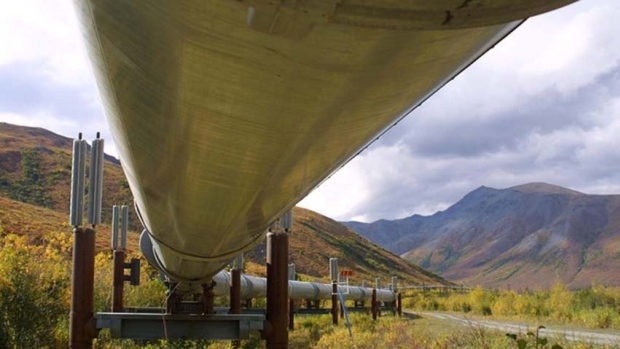VANCOUVER - U.S. scientists are warning that there are environmental risks, regulatory holes and serious unknowns regarding the shipment of Alberta oilsands products by pipeline, rail and tanker.
The findings are in a 153-page report from last September by the emergency response division of the U.S. National Oceanic and Atmospheric Administration. The unit has expertise in preparing for, evaluating and responding to oil and chemical spills in coastal environments.
Enbridge (TSX:ENB), the company behind the proposed Northern Gateway pipeline to the British Columbia coast, counters that most of the concerns raised in the report are out-of-date, overstated or being resolved.
The study examined the different ways to transport Alberta's bitumen, a molasses-like crude oil, over U.S. land and water. Those included rail, the proposed Kinder-Morgan Trans Mountain pipeline to Vancouver, the Keystone XL line to Texas from Alberta, and Northern Gateway.
"Most oilsands products are transported to market via existing and proposed pipelines; however, a sharp increase in the use of rail and marine transport can be expected while new pipelines are constructed to match the increased production of oilsands products," the report says.
It was written by six experts at the University of Washington and supervised by Prof. Robert Pavia of the university's School of Marine and Environmental Affairs.
"While there are many arguments about the level of risk, no one believes the risk is zero," Pavia told The Canadian Press, adding that he was speaking personally. "In my mind it's not a question of whether a spill will occur, but how well-prepared we are for a spill once it does occur."
In the case of Northern Gateway, not only might there be potential to harm Washington state shores, there could be hazards from tankers leaving Kitimat, B.C., to travel through the waters of Alaska, near the Aleutian Islands to Asia. The proposed 1,177-kilometre-long pipeline would carry 525,000 barrels of bitumen daily from Alberta to the northern B.C. port.
Both Canada and the United States need to renew and expand efforts to reduce any risks, Pavia said.
Last December, a federal joint review panel supported the project — providing Enbridge meets 209 conditions. The final decision rests with the federal cabinet.
The U.S. report notes there are information gaps about the transport of bitumen.
"Little research is currently available regarding the behaviour of oilsands products spilled into water, and how they weather in the environment," the report says.
"Most tests have been conducted in the laboratory, so predicting the actual behaviour of oilsands products for a range of spills is difficult." The risks associated with carrying oilsands products over water "are not well-defined."
The study does point out that only a handful of spills have occurred in the U.S. and Canada.
Enbridge communications manager Ivan Giesbrecht said that's a positive thing.
"This further supports that these products do not pose increased risk for transmission pipeline corrosion," he said in an interview.
In 2007, a neighbourhood in Burnaby, B.C., was covered in synthetic crude when excavation equipment ruptured a pipeline. In 2010, a pipeline leaked 20,000 barrels of oil into the Kalamazoo River in Michigan.
Last September's report also points out that anyone responding to an oilsands spill could face both oil that is light and floating or heavier oil that could sink.
"This could impact fish and birds that move between water and air, such as those that may inhale toxic fumes, or become coated by oil. Sinking oil could move into the water column and harm fish larvae.
"Current capabilities to detect and recover oil when it sinks or is suspended in the water column are poor."
Giesbrecht said each spill is unique and depends on where and when it occurs. He said it is also "an incorrect assumption," one not supported by studies or observations, that diluted bitumen in water would split into two portions of floating and sinking oil.
A Canadian government study released earlier this month shows that diluted bitumen does sink in salt water when battered by waves and mixed with sediment. If the bitumen is free of sediment, the crude floats even after evaporation and exposure to light.
The U.S. study says research is needed into the public health impacts of oilspills, weathering effects and biodegradation, and there should be more testing with a wider variety of oilsands products.
Giesbrecht said that Enbridge plans to join, with government and industry, a committee of technical experts to research spill behaviour and response. He also said the industry has already started to conduct such research.
Giesbrecht said Enbridge doesn't agree with the findings of the U.S. study. He said the company is committed to applying industry best practices and to developing leak-detection technologies.
The report also noted "regulator shortcomings," including that oilsands products aren't subject to the U.S. excise tax that provides funds for spill cleanup, and that there was scant product information provided by the facilities that transport the oil they're handling.
"There are additional gaps in policies and regulations that warrant scrutiny as transport of oilsands products and other unconventional oils increases," the report said.
Federal and state railway regulators have played a minor role in oil spill planning, but given recent high-profile accidents, like the deadly crash and explosion in Lac-Megantic, Que., the report suggests more regulatory oversight over rail transport should be considered.
U.S. study warns of risks and unknowns in shipment of Alberta oilsands products























Laissez un commentaire Votre adresse courriel ne sera pas publiée.
Veuillez vous connecter afin de laisser un commentaire.
Aucun commentaire trouvé